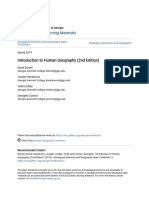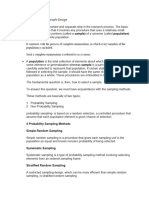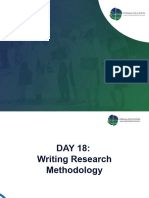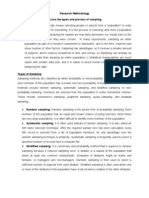0 ratings0% found this document useful (0 votes)
6 viewsMarilou Budhi (The Research Process)
Marilou Budhi (The Research Process)
Uploaded by
Mj CabangananThis document outlines the key steps in the research process, including deciding on the sample design and data collection methods. [1] It discusses sampling as selecting a small number of items from a larger population. [2] There are two main types of sampling: probability sampling which uses a random selection process, and non-probability sampling which uses subjective judgement. [3] The document then explains various methods for collecting both quantitative and qualitative data.
Copyright:
© All Rights Reserved
Available Formats
Download as PPTX, PDF, TXT or read online from Scribd
Marilou Budhi (The Research Process)
Marilou Budhi (The Research Process)
Uploaded by
Mj Cabanganan0 ratings0% found this document useful (0 votes)
6 views14 pagesThis document outlines the key steps in the research process, including deciding on the sample design and data collection methods. [1] It discusses sampling as selecting a small number of items from a larger population. [2] There are two main types of sampling: probability sampling which uses a random selection process, and non-probability sampling which uses subjective judgement. [3] The document then explains various methods for collecting both quantitative and qualitative data.
Copyright
© © All Rights Reserved
Available Formats
PPTX, PDF, TXT or read online from Scribd
Share this document
Did you find this document useful?
Is this content inappropriate?
This document outlines the key steps in the research process, including deciding on the sample design and data collection methods. [1] It discusses sampling as selecting a small number of items from a larger population. [2] There are two main types of sampling: probability sampling which uses a random selection process, and non-probability sampling which uses subjective judgement. [3] The document then explains various methods for collecting both quantitative and qualitative data.
Copyright:
© All Rights Reserved
Available Formats
Download as PPTX, PDF, TXT or read online from Scribd
Download as pptx, pdf, or txt
0 ratings0% found this document useful (0 votes)
6 views14 pagesMarilou Budhi (The Research Process)
Marilou Budhi (The Research Process)
Uploaded by
Mj CabangananThis document outlines the key steps in the research process, including deciding on the sample design and data collection methods. [1] It discusses sampling as selecting a small number of items from a larger population. [2] There are two main types of sampling: probability sampling which uses a random selection process, and non-probability sampling which uses subjective judgement. [3] The document then explains various methods for collecting both quantitative and qualitative data.
Copyright:
© All Rights Reserved
Available Formats
Download as PPTX, PDF, TXT or read online from Scribd
Download as pptx, pdf, or txt
You are on page 1of 14
THE RESEARCH PROCESS
STEP 5: DECIDING ON THE SAMPLE DESIGN
• Sampling is an important and separate step in the
research process. The basic idea of sampling is that it
involves any procedure that uses a relatively small
number of items or portions (called a sample) of a
universe (called population) to conclude the whole
population.
• A population is the total collection of elements
about which we wish to make some inference or
generalization whereas sample is a part of the
population, carefully selected to represent that
population. If certain statistical procedures are
followed in selecting the sample, it should have
the same characteristics as the population as a
whole.
1. Probability Sampling- is based on a random selection, a controlled
procedure that assures that each population is given chance of
selection
2. Non-Probability Sampling- is a non-random and subjective method
of sampling where the selection of the sample’s population elements
depends on the personal judgement or the discretion of the sampler
STEP 6: COLLECTING DATA
The gathering of data may range from
simple observation to a large-scale survey
in any defined population. There are many
ways to collect data. This includes:
PROBABILITY SAMPLING METHODS
1. Simple Random Sampling
2. Systematic Sampling
3. Stratified Random Sampling
4. Cluster Sampling
NON-PROBABILITY SAMPLING METHODS
1. Convenience Sampling- non-probability samples that are unrestricted are known
as convenience samples.
2. Purposive sampling- non-probability method that conforms to certain criteria.
3. Quota Sampling- a non-probability sampling in which the interviewers are to
contact and interview a certain number of individuals from certain subgroups or
strata of the population to make up the total sample.
4. Snowball Sampling- is the colorful name for building a list or a sample of a
special population.
o The most common means for collecting quantitative data is
the structured interview. Studies that obtain data by
interviewing respondents are called surveys. Data can
also be collected by using self-administered
questionnaires. Telephone interviewing is another way
in which data may be collected. Other means of data
collection include the use of secondary sources, such as
the census, vital registration records, official documents,
previous surveys, etc.
• Meanwhile, Qualitative data are collected mainly
through in-depth interviews, focus group
discussions, KII, and observational studies.
STEP 7: PROCESSING AND ANALYZING DATA
• Data processing generally begins with the editing and coding
of data. Data are edited to ensure consistency across
respondents and to locate omissions, if any.
• Data analysis usually involves reducing accumulated data to
a manageable size, developing summaries, searching for
patterns, and applying statistical techniques for
understanding and interpreting the findings in the light of the
research questions.
• Further, the researcher, based on his analysis, determines if
his findings are consistent with the formulated hypotheses and
theories.
STEP 8: WRITING THE REPORT – DEVELOPING RESEARCH
PROPOSAL, WRITING REPORT, DISSEMINATING AND
UTILIZING RESULTS
• The entire task of a research study is accumulated in a
document called a proposal. A research proposal is a
work plan, prospectus, outline, an offer, a statement of
intent or commitment from an individual researcher or
an organization to produce a product or render a
service to a potential client or sponsor.
• A report is an excellent means that helps to establish the
researcher’s credibility. At a bare minimum, a research report
should contain sections on:
• An executive summary;
• Background of the problem;
• Literature review;
• Methodology;
• Findings;
• Discussion;
• Conclusions and
• Recommendations.
Thank you!!!
You might also like
- Suzuki Alto Electrical Wiring DiagramDocument99 pagesSuzuki Alto Electrical Wiring Diagramromo25% (28)
- Introduction To Human Geography (2nd Edition)Document285 pagesIntroduction To Human Geography (2nd Edition)陈荧莹100% (1)
- Step 5Document7 pagesStep 5Mj CabangananNo ratings yet
- MATH 403 Module 1.0 Data Collecrion and Conducting SurveysDocument21 pagesMATH 403 Module 1.0 Data Collecrion and Conducting SurveysgirlinyellowhoodieNo ratings yet
- CHP 7 - Research - Process - Part - IIIDocument27 pagesCHP 7 - Research - Process - Part - IIIsinghyashwant102No ratings yet
- App 005 Day 18 20Document42 pagesApp 005 Day 18 20Arache' EstradaNo ratings yet
- Research SubDocument5 pagesResearch SubKyra Aliyah SambranoNo ratings yet
- 3iii Q3 W2 2023-2024Document27 pages3iii Q3 W2 2023-2024cristina.bisquera02No ratings yet
- Foundation of Communication ResearchDocument7 pagesFoundation of Communication Researchmaltildadouglas59No ratings yet
- Applied Marketing Session 4 Final NotesDocument12 pagesApplied Marketing Session 4 Final NotesMobeen KhanNo ratings yet
- Research MethodoloyDocument13 pagesResearch MethodoloyNivedita SolankeNo ratings yet
- Research Process 8 StepDocument8 pagesResearch Process 8 Stepizazalicutie07No ratings yet
- Types Methods of ResearchDocument77 pagesTypes Methods of Researchharabarakabab12No ratings yet
- Class CH 5Document22 pagesClass CH 5wabdushukurNo ratings yet
- Chapter 1-Obtaining DataDocument29 pagesChapter 1-Obtaining DataHanna Joy LasiNo ratings yet
- Unit IiDocument47 pagesUnit IiAnshitNo ratings yet
- Collecting and Generating Quantitative DataDocument15 pagesCollecting and Generating Quantitative DataRabiahtul Asiah100% (1)
- Assignment of SPSSDocument12 pagesAssignment of SPSSAkshay poplyNo ratings yet
- Research Methodology - Short NotesDocument73 pagesResearch Methodology - Short Notesshibasundar193No ratings yet
- Chapter 1-Obtaining DataDocument25 pagesChapter 1-Obtaining DataHanna Joy LasiNo ratings yet
- Research ProcessDocument23 pagesResearch ProcessRushin KothariNo ratings yet
- SEC PPR Unit 1 Topic 2Document7 pagesSEC PPR Unit 1 Topic 2P R I T H ANo ratings yet
- Research MethodologyDocument11 pagesResearch MethodologyBhawna Khurana100% (1)
- Research Chapter 4Document10 pagesResearch Chapter 4Bantamkak FikaduNo ratings yet
- Methods of Data CollectionDocument22 pagesMethods of Data Collectionkim.lastimaNo ratings yet
- Descriptive ResearchDocument14 pagesDescriptive ResearchMark Augustus ConsolacionNo ratings yet
- Research ProcessDocument21 pagesResearch ProcessHruday ChandNo ratings yet
- Engineering Reasearch MethodologyDocument32 pagesEngineering Reasearch MethodologyKonney NaveenNo ratings yet
- Research Method-WPS OfficeDocument3 pagesResearch Method-WPS OfficethiikmakethNo ratings yet
- Research Data Types and MethodologyDocument24 pagesResearch Data Types and MethodologyAyne NewtonNo ratings yet
- EHS425 - Chapter 2 - 02272024 - W2Document20 pagesEHS425 - Chapter 2 - 02272024 - W2Aya YassineNo ratings yet
- 10Document81 pages10lloydsemolavaNo ratings yet
- CH 6 Data Collection ProcedureDocument3 pagesCH 6 Data Collection ProcedureShoyeab Rahman AbirNo ratings yet
- Accounting Research Methods Chapter 4Document81 pagesAccounting Research Methods Chapter 4Glaiza LerioNo ratings yet
- Research DesignDocument31 pagesResearch DesignrahelNo ratings yet
- Chapter 3 Descriptive ResearchDocument4 pagesChapter 3 Descriptive ResearchKier Del RosarioNo ratings yet
- Explain The Meaning of Descriptive ResearchDocument5 pagesExplain The Meaning of Descriptive ResearchNicoleSofia GalleneroNo ratings yet
- Topic: The Continuum of Philosophy.: Quantitative ResearchDocument9 pagesTopic: The Continuum of Philosophy.: Quantitative ResearchHina KaynatNo ratings yet
- (Chapter 3) Narrative ReportDocument7 pages(Chapter 3) Narrative ReportMachi KomacineNo ratings yet
- 210 QRM Qus 3 Year Solved KKDocument68 pages210 QRM Qus 3 Year Solved KKmurudkaraditya110No ratings yet
- Module 1-Obtaining DataDocument29 pagesModule 1-Obtaining DataHanna Joy LasiNo ratings yet
- Chapter Ii MethodsDocument53 pagesChapter Ii MethodsMaritesNo ratings yet
- Group 7 Descriptive ResearchDocument18 pagesGroup 7 Descriptive ResearchGenuslee MapedzeNo ratings yet
- Week 3Document37 pagesWeek 3gowthamithra monishaNo ratings yet
- 3i's REVIEWERDocument2 pages3i's REVIEWERNicole Ann BaroniaNo ratings yet
- Blue-Illustrative-Research-Presentation 20241031 105147 0000Document19 pagesBlue-Illustrative-Research-Presentation 20241031 105147 0000saludartrecia730No ratings yet
- BRM-1 NotesDocument36 pagesBRM-1 Notessubham not a nameNo ratings yet
- Assessment Task 2 - Short Question and Answer: Part A - Short QuestionsDocument8 pagesAssessment Task 2 - Short Question and Answer: Part A - Short QuestionsMemay Methawee100% (1)
- Udd Med Filipino Summer Final ExamDocument6 pagesUdd Med Filipino Summer Final Exambryl john lawrence villamarNo ratings yet
- PMPRT 1Document30 pagesPMPRT 1Rosalinda LigaoNo ratings yet
- Statistics - DR Malinga - Notes For StudentsDocument34 pagesStatistics - DR Malinga - Notes For StudentsRogers Soyekwo KingNo ratings yet
- Havells FinalDocument59 pagesHavells FinalprateekNo ratings yet
- HRM 321 3rd LectureDocument20 pagesHRM 321 3rd LectureLutho NdlaziNo ratings yet
- Ch-3 Research Methodology: 3.1 Concept MethdologyDocument8 pagesCh-3 Research Methodology: 3.1 Concept MethdologyMegha JainNo ratings yet
- Methodologies: 6.1 Measurement, Reliability and Validity 6.2 Data Gathering TechniquesDocument22 pagesMethodologies: 6.1 Measurement, Reliability and Validity 6.2 Data Gathering TechniquesGeronimo Aben Gutierrez Jr.No ratings yet
- PR2 Module 5 Part 2Document10 pagesPR2 Module 5 Part 2Kc RondaNo ratings yet
- Sample Survey 007Document35 pagesSample Survey 007caleb castilloNo ratings yet
- Research Ii: Quarter 4Document30 pagesResearch Ii: Quarter 4ridenejazz6No ratings yet
- What Is Research? Why Is Research Essential in Business, Give Two Reasons?Document36 pagesWhat Is Research? Why Is Research Essential in Business, Give Two Reasons?Saurabh KumbharNo ratings yet
- Sampling 2Document8 pagesSampling 2varshasanthanamadv15No ratings yet
- Participatory Action Research for Evidence-driven Community DevelopmentFrom EverandParticipatory Action Research for Evidence-driven Community DevelopmentNo ratings yet
- 1 Merged 2Document52 pages1 Merged 2Mj CabangananNo ratings yet
- Rules and RegulationDocument6 pagesRules and RegulationMj CabangananNo ratings yet
- Inventory Is FullDocument10 pagesInventory Is FullMj CabangananNo ratings yet
- PSYCHOLOGICAL FOUNDATION OF EDUCATION FinalDocument12 pagesPSYCHOLOGICAL FOUNDATION OF EDUCATION FinalMj CabangananNo ratings yet
- R E S T R I C T E D 387: Magna Carta of Women Republic Act No. 9710 - An Act Providing For The Magna Carta of WomenDocument23 pagesR E S T R I C T E D 387: Magna Carta of Women Republic Act No. 9710 - An Act Providing For The Magna Carta of WomenMj CabangananNo ratings yet
- Personality Development: Alok K. Dubey Mail ToDocument19 pagesPersonality Development: Alok K. Dubey Mail ToMj CabangananNo ratings yet
- AnswersDocument2 pagesAnswersMj CabangananNo ratings yet
- Multiple Choice 6Document3 pagesMultiple Choice 6Mj CabangananNo ratings yet
- Ha FDFGDocument62 pagesHa FDFGMj CabangananNo ratings yet
- August 12, 2019 CE 515 Assignment #2Document2 pagesAugust 12, 2019 CE 515 Assignment #2Mj CabangananNo ratings yet
- Single Response 1Document2 pagesSingle Response 1Mj CabangananNo ratings yet
- A Portfolio: Samar CollegeDocument12 pagesA Portfolio: Samar CollegeMj CabangananNo ratings yet
- A Do HHGDocument9 pagesA Do HHGMj CabangananNo ratings yet
- Concrete: Strength of Concrete. The Tensile Strength of Concrete Is Measured by The Units of Force PerDocument1 pageConcrete: Strength of Concrete. The Tensile Strength of Concrete Is Measured by The Units of Force PerMj CabangananNo ratings yet
- Impulse Metal DetectorDocument12 pagesImpulse Metal Detectorsleshi100% (1)
- Max Session-IDocument28 pagesMax Session-IelrajilNo ratings yet
- Lesson 5: Gathering Information From SurveysDocument18 pagesLesson 5: Gathering Information From SurveysAngelou CruzNo ratings yet
- Easy Altivar 310 - ATV310HU22N4EDocument6 pagesEasy Altivar 310 - ATV310HU22N4EPhaniNo ratings yet
- Kes Inset Narrative Feb 2022Document7 pagesKes Inset Narrative Feb 2022Mary Rosedy DetaysonNo ratings yet
- Valentina House - Text AnalysisDocument3 pagesValentina House - Text AnalysisriswitaNo ratings yet
- Dw02 Mult 6 StageDocument4 pagesDw02 Mult 6 StageroseootyNo ratings yet
- LRA067AT7 Air Cond Installation 2020211a1446Document4 pagesLRA067AT7 Air Cond Installation 2020211a1446guidoneroNo ratings yet
- PK TUGAS BAB 15 Dicky Panduwinata 41321010007Document12 pagesPK TUGAS BAB 15 Dicky Panduwinata 41321010007Fanuel Hardori 12tbsm1No ratings yet
- Portable Nav/Comm Test Set: Product SpecificationDocument6 pagesPortable Nav/Comm Test Set: Product SpecificationLin NitiNo ratings yet
- Major Topic:: Grade 8 Physical ScienceDocument46 pagesMajor Topic:: Grade 8 Physical ScienceClaudia FannyNo ratings yet
- Chandra, A. M - Geoinformatics-New Academic Science (2017)Document205 pagesChandra, A. M - Geoinformatics-New Academic Science (2017)Sabin Nicula100% (1)
- Al2216w Quick Start GuideDocument11 pagesAl2216w Quick Start GuideKelly HoffmanNo ratings yet
- For All Things Flowing.: BornemannDocument8 pagesFor All Things Flowing.: BornemannBojez zZzNo ratings yet
- Ellis Patents Cable Cleats Complete CatalogueDocument28 pagesEllis Patents Cable Cleats Complete CataloguefndprojectNo ratings yet
- A Personality Trait-Based Interactionist Model of Job PerformanceDocument18 pagesA Personality Trait-Based Interactionist Model of Job PerformanceAlvina AhmedNo ratings yet
- Physical Geography Pyqs (1995 - 2020) : Telegram: Personal ContactDocument40 pagesPhysical Geography Pyqs (1995 - 2020) : Telegram: Personal ContactAbhimanyu SinghNo ratings yet
- 5 - Aircraft Structural LayoutDocument35 pages5 - Aircraft Structural LayoutLaura Portella FeihNo ratings yet
- Dew PointDocument6 pagesDew PointtipusemuaNo ratings yet
- The International Social and Cultural EnvironmentDocument3 pagesThe International Social and Cultural EnvironmentAkash DhokeNo ratings yet
- Bag Filter CalculationDocument3 pagesBag Filter CalculationJag Khadse100% (1)
- Model Question Paper: 18ME15/25 18ME15/25Document2 pagesModel Question Paper: 18ME15/25 18ME15/25Manjunatha EikilaNo ratings yet
- Lecture 1Document31 pagesLecture 1Yan YanNo ratings yet
- Business PlanDocument67 pagesBusiness PlanVinarao Raiza M.No ratings yet
- TDL Taxo 8AL90923USAA 12 enDocument576 pagesTDL Taxo 8AL90923USAA 12 enMohamed SalhiNo ratings yet
- Vocational Training Report: Indian Oil Corporation LTDDocument36 pagesVocational Training Report: Indian Oil Corporation LTDChandan KumarNo ratings yet
- New Urbanism: BackgroundDocument11 pagesNew Urbanism: BackgroundMaría Fernanda AntillónNo ratings yet
- Composite MaterialsDocument58 pagesComposite MaterialsOceman KhanNo ratings yet







































































































